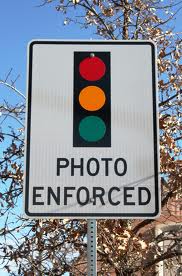A Fort Bend County activist wants to pull the plug on Sugar Land’s red-light cameras, but city officials aren’t about to budge on their plans to ticket motorists caught on camera running red lights.
H.F. Van Der Grinten, a semiretired shipmaster, took his message to Sugar Land Municipal Court at 1200 Texas 6 early Monday, where he criticized the city’s red-light camera ordinance.
“Red-light cameras are unfair to the driving public because drivers are forced to guess how long the yellow light will remain illuminated,” said Van Der Grinten, 72, who lives in New Territory in Sugar Land’s extraterritorial jurisdiction. “Red-light cameras do not reduce accidents, and they amount to little more than taxation by method of random selection.”
Van Der Grinten distributed fliers to motorists who appeared before a hearing officer to protest their red-light tickets. The handouts urged motorists to demand their ticket be dismissed because photographic evidence “does not identify me as the driver of the vehicle cited.”
Some other dude is quoted in the story saying that red light cameras are about revenue and not law enforcement. As they say, it’s like deja vu all over again.
And if that weren’t enough, there’s League City.
The company that manages the red-light camera equipment for the city sued League City about the upcoming election that would give voters a chance to get rid of the system.
Redflex Traffic Systems claims the ballot language is too vague, confusing and violates the company’s contract with the city.
Earlier this month, the city council approved the ballot measure that would allow the voters to decide if the red-light cameras should continue once the city’s contract with Redflex expires in 2014.
Redflex claims that the ballot language the council approved — in which a “yes” vote would remove the cameras and a “no” vote would keep the status quo — is confusing.
“Additionally, the proposition as worded is misleading and confusing because a vote ‘for’ the proposition is a vote ‘against’ the ordinance and the city’s current policy with respect to the use of red light cameras,” the company claims in its lawsuit filed in the 122nd District Court in Galveston County on Thursday.
Mayor Tim Paulissen called Redflex’s lawsuit frivolous and hopes a judge will toss it out.
I’m so happy that we’re just voting on boring old bond referendums and that Metro proposition. I don’t miss this debate at all.


Van der Grinten needs to take a driver ed refresher. When you see a yellow light, you slow and stop if at all possible. No guesswork on timing required.
John: Haven’t you been wondering why all those people are rearending you? Anyone who follows your advice will get rearended, too.
As we can see from the crash videos the camera industry shows us, the real dangerous runs are many seconds into the red. Most of them occur because the intersection (and the signal) isn’t prominent enough – the motorist (a visitor, or a drunk/impaired local) may miss seeing it, entirely, or he may think it’s not a major intersection. (And a camera won’t stop them, because the visitor doesn’t know it’s there, and the local doesn’t remember it’s there.) Here’s how to make an intersection (and signal) more prominent. Cheaply and quickly.
A. Paint “signal ahead” on the pavement. A study sponsored by Florida’s DOT found that doing so could cut running by up to 74%.
B. Make the signal lights bigger in diameter or, add another signal head. A study by the Texas Transportation Institute (TTI) found that doing either one could cut crashes by 47%.
C. Add backboards to the signal heads, or enlarge those you have. The TTI study found that doing so could cut crashes by 32%.
D. For nighttime driving, install brighter bulbs in the street lights and put up lighted name signs for the cross street.
These things should be tried at a city’s worst intersections, and the results published, before there is any consideration of putting in red light cameras.
@Henry, I’m calling BS on that statement. I slow down and stop at yellows whenever possible, and have never been rear ended. In fact, the only time I’ve been rear ended was mid block.
I wonder why we don’t do like Mexico and do this: steady green light works just like here. Green starts to flash to let you know that it’s going to turn yellow, and then it turns steady yellow, and then steady red.
As crazy as traffic in Mexico City is, this seems to prevent a last second judgement of rushing only to end up going through a red light, from my experience.